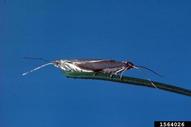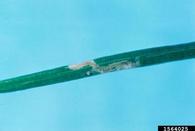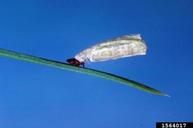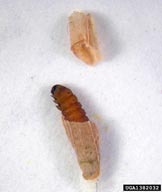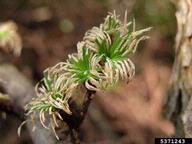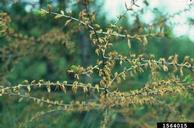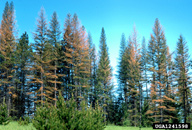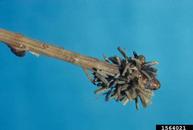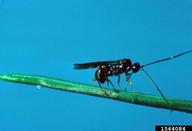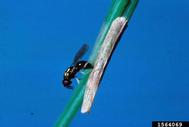Larch casebearer
Coleophora laricella [Hübner]) (Lepidoptera: Coleophoridae)
Orientation to pest
The larch casebearer, Coleophora laricella [Hübner]), is an invasive species from Europe that caused extensive defoliation of North American larch before it was brought under biological control. It has one generation per year. Adults emerge in late spring and deposit their eggs singly on needles in early summer. Newly hatched larva bore into needles and feed as needle miners. After larvae consume a portion of their first needle, a section of a mined-out needle is lined with silk, cut free, and carried as a case. Larvae in cases then move to other needles and continue to feed. Fed-on needles are only partly consumed. They remain attached to branches but turn brown, making damage readily visible. Cases are enlarged as larvae grow. Larvae overwinter in cases fixed to branches and resume feeding in spring on new foliage. Upon reaching maturity, larvae pupate in their cases from which moths later emerge.
Hosts commonly attacked
In North America, this moth attacks both eastern (Larix laricina [Du Roi] K. Koch) and western (Larix occidentalis Nuttl.) larch.
Distribution
Larch casebearer occurs in Canada from the Maritmes to western Canada and in the United States from New England to Minnesota and, separately, in Washington, Oregon, Idaho and western Montana. This distribution corresponds to that of eastern and western larch.
Images of larch casebearer
| Figure 1. Adults of larch casebearer, Coleophora laricella, mating | Figure 2. Young larva of larch casebearer in needle-mining phase | Figure 3. Older larva of larch casebearer with case | Figure 4. View of larch casebearer larva with case partially removed |
| Figure 5. Close view of damage to needles caused by larch casebearer larval feeding | Figure 6. Branch showing yellow foliage that has been partly consumed by larch casebearer | Figure 7. Larch stand showing reddish-brown foliage due to feeding of larch casebearer |
| Figure 8. Cluster of overwintering larch casebearer in cases at tip of twig | Figure 9. The braconid Agathis pumila (Ratzburg), one of two key species giving successful biological control of larch casebearer in North America. | Figure 10. The eulophid Chrysocharis laricinellae Ratzburg, showing egg-laying behavior |
Important biological control agents related to this pest species
While a larger number of parasitoids were introduced, two species - the braconid Agathis pumila (Ratzburg) and the eulophid Chrysocharis laricinellae Ratzburg - were responsible for effective biological control of larch casebearer in North America.
Web links for information on larch casebearer
- Forest Insect & Disease Leaflet 96 | USDA Forest Service
- Forest Health Note | Oregon Department of Forestry FHP
Provides information for the non-industrial private forest landowner - Return of Larch Casebearer | Article providing information on damage and biological control
Articles
- Jagsch, A.1973. Population dynamics and parasite complex of the larch miner, Coleophora laricella Hb., in the natural distribution area of European larch, Larix decidua Mill. Zeitschrift für Angewandte Entomologie 73: 1-42.
- Niwa, G. G. 1983. Environmental factors influencing the effectiveness of Agathis pumila Ratz. (Hymenoptera: Braconidae), an introduced parasite of the larch casebearer, Coleophora laricella Hbn. (Lepidoptera: Coleophoridae). Forestry Abstracts 44 (11): 718.
- Niwa, C. C., R. W. Stark, D. G. Burnell, and D. M. J. Knox. 1986. Annotated bibliography of larch casebearer (Coleophora laricella) parasitoids. Bulletin No. 41. Forest, Wildlife and Range Experiment Station, University of Idaho. 135 pp.
- Ryan, R. B. 1990. Evaluation of biological control: introduced parasites of larch casebearer (Lepidoptera: Coleophoridae) in Oregon. Environmental Entomology 19: 1873-1881.
- Ryan R. B. 1997. Before and after evaluation of biological control of the larch casebearer (Lepidoptera: Coleophoridae) in the Blue Mountains of Oregon and Washington, 1972-1995. Environmental Entomology 26: 703-715.
